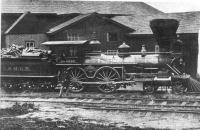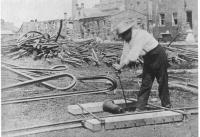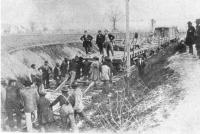The O&A was the sister railroad of the A,L&H. The USMRR also took over the O&A. It joined the two railroads at the hip in Alexandria by constructing a short piece of track. The Union and the Confederacy fought hard over the Orange and Alexandria, because it connected Washington, D.C. to central Virginia and to points south. More on the Orange & Alexandria
 In the picture above, Mosby is the on the left. Credit: Library of Congress
In the picture above, Mosby is the on the left. Credit: Library of Congress
Excerpts from Melville's poem, "The Scout Toward Aldie":
Meanwhile the mounted captives near
Jested; and yet they anxious showed;
Virginians; some of family-pride,
And young, and full of fire, and fine
In open feature and cheek that glowed;
And here thralled vagabonds now they ride --
But list! one speaks for Mosby's side.
"Why, three to one -- your horses strong --
Revolvers, rifles and a surprise
Surrender we account no shame!
We live, are gay, and life is hope;
We'll fight again when fight is wise.
There are plenty more from where we came;
But go find Mosby -- start the game!"
The Yankees Seize It | Mosby Raids It | Links | Sites On Trail
No state suffered more than Virginia in the Civil War and this railroad was no
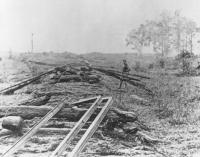
|
|
| Twisted rails could not be straightened. Damage done by Lee's army retreating from Gettysburg, in Virginia on the O&A. Photographer: Timothy O'Sullivan. Library of Congress. |
A Railroad Controlled By The North
The Confederates and the Union fought several skirmishes and one battle along the railroad during the first year of the war. Gradually, through their sheer numbers, the Yankees pushed the Rebels away from Washington, D.C., and hence away from the railroad. The fighting shifted both southwards (to Fredericksburg and Richmond) and westwards (to the Shenandoah Valley.) There were exceptions to this. Lee's two invasions of the North crossed through the region formerly served by the Alexandria, Loudoun and Hampshire Railroad. A third invasion of the North, the raid by Confederate General Early to the outskirts of Washington at Fort Stephens, ended in a retreat through Loudoun County, Virginia. Also Confederate John Mosby's partisan cavalry harassed the Yankee occupiers of the railroad, from 1863 until the end of the war. But in general the North controlled this railroad for most of the war.
The railroad had three engines when the War started. After Virginia seceeded from the United States, the Alexandria, Loudoun and Hampshire railroad operated under the Confederates for one month. In May, 1861, the United States invaded Alexandria. On that day Union troops captured the train coming from Leesburg.
|
|
|
| A map of the railroad on the eve of the Civil War, 1859. Source: Library of Congress |
In June, 1861, outside of Vienna, (Mile 11.4) the Confederates ambushed a troop train being pushed by an engine but the engineer shifted the engine into reverse, saving the engine. He left the soldiers to retreat on foot. The tracks suffered a worse fate. The Confederates burned the bridge over Difficult Run (Mile 14.5) in 1861. A year later Lee's army destroyed the tracks in the vicinity of Reston.
In 1861 the United States Military Railroad took over what was left of the Alexandria, Loudoun and Hampshire Railroad. In 1862 the president of the AL&H, a Union sympathizer, urged Secretary of War Stanton to rebuild it to Leesburg and beyond, but the government refused.
The government used the stub of the railroad to supply the garrisons which defended Washington. The Union constructed a ring of seventy forts around Washington, making it the most heavily-fortified city in the world. The railroad passed through this ring of forts at Mile 0.5, Walter Reed Drive. Text of historical markers about these two forts. Beyond these forts the Union built a ring of cavalry camps, including Fairfax Court House, Occoquan, Vienna, and later, Centreville. Because it was on the railroad, Vienna was one of the most important of these camps.
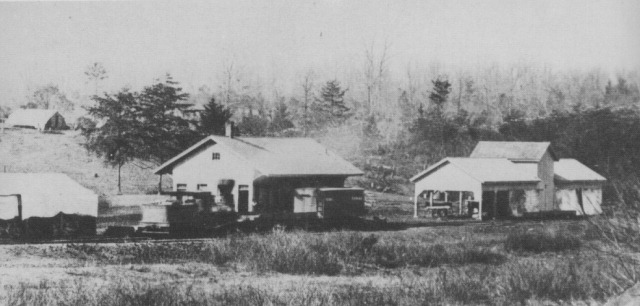
|
|
| A U.S. Military Railroad train pulls into Vienna station, 1864. The station looks different than it does today because Southern Railroad remodeled the station in 1876. Photo credit: U.S. Army Military History, Carlisle Barracks |
John S. Mosby Raids The Area Served By the Railroad
Mosby commanded the most famous of the partisan units operating behind Union lines. The Confederate Congress authorized these units in April, 1862, but Mosby's unit did not begin operations until January, 1863. These units tended to spin out of control. In a time of war fought according to rules, guerrilla units did not fit in. Forced to find their own supplies, they tended to prey on not only the enemy but also the friendly civilians. In other words they became outlaws. In February, 1864 the Confederate Congress reversed itself, revoking the authority of these units. Mosby's unit was one of two which were allowed to continue to operate behind enemy lines.
As a commander, Mosby's first action was to attack pickets outside of Herndon Station. He captured horses and prisoners, but he did not take Herndon itself. Mosby could not conquer territory; instead he could only attack and retreat with prisoners and supplies.
Herman Melville, a civilian, stayed at Vienna. As the guest of Lowell, on April 18, 1864, Melville rode with Lowell's troopers looking for Mosby. Riding west from Vienna, the Yankees followed the bed of the destroyed railroad to Sterling. In Sterling they left the railroad, turning left onto Church Road. They spent the first night on Goose Creek. On the next day they almost captured a few of Mosby's men at a wedding in what is today called, "The Laurel Brigade Inn" in Leesburg. Excerpts from Melville's poem about this ride are to the left.
More Links
- More on Mosby from The Post
- Southern Museum of Civil War History and Locomotives, to open in 2003.
- Mosby Heritage Area
- Falls Church during the war.
- If you like histories of Civil War railroads, try The Great Locomotive Chase: The Story of Andrew's Raiders
- Mosby is one of the most famous figures in the war. Here are some links about him:
- Mosby's memoirs on-line
- The roster of the 43rd Virginia Cavalry, which was the official name of Mosby's Rangers.
- Mosby's Confederacy, the area of northern Fauquier and southern Loudoun Counties.
- Seasons Of War, by Daniel Sutherland. A social history of Culpeper County, Virginia during the War; not a military history. It explains a lot about the Orange and Alexandria Railroad, sister railroad of the A,L&H. Check it out!
- The Washington Times runs an article on the Civil War each Saturday. Often the subject is local history.
- Loudoun Rangers, the only official northern unit recruited in Virginia.
- More on some of the battlefields near the trail:
- Mile Hill Skirmish, in Leesburg not far from the trail at Mile 34.6, and also in Movren Park, a destination in its own right.
- Efforts to preserve Balls Bluff battlefield from The Washington Post
- Although it is about thirteen miles beyond the terminus of the trail, Cool Spring Battlefield is worth a visit. It was a flanking battle during the raid by Early on Washington in 1864. Early destroyed parts of the B&O Railroad on his raid.
- You can earn a Master's degree in Civil War studies!
This page was last modified Jan 3, 2003.

